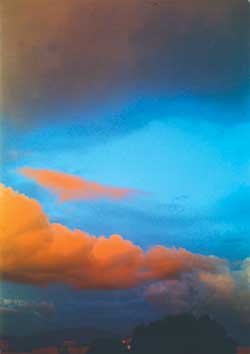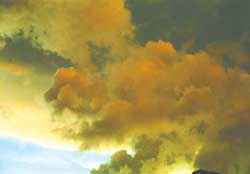 On the satellite pictures they appear as large dark masses of clouds travelling up from the Bay of Bengal. The TV forecasters warn you that "there is a bit of bad weather moving up to the Himalaya". Bad weather?
On the satellite pictures they appear as large dark masses of clouds travelling up from the Bay of Bengal. The TV forecasters warn you that "there is a bit of bad weather moving up to the Himalaya". Bad weather? For whom?
Nothing could be better than a good, healthy monsoon For three months in a year, the Himalaya from Kashmir to Assam act as a gigantic atmospheric dam to store water vapour. The mountains are such an effective barrier that the Tibetan plateau to the north is left literally high and dry in the rain shadow.
Pre-monsoon showers are cataclysmic events. Pumped by the heat, huge convection currents send cauldrons of cumulus rising vertically into the atmosphere, sometimes more than 50,000 feet. Up there in the stratosphere, the jet stream smears their tops into wild angry cobra heads. On one pre-monsoon afternoon, I once watched the entire Ganesh massif dwarfed in the shadow of one of these big cauliflowers of moisture. The convection system rose out of the Buri Gandaki Valley to ride on flashing neon legs of purple lightning. From high up on a ridge above Dhunche we watched transfixed as the afternoon sun was blotted out, and the snowy slopes of Langtang Lirung lost their light. It suddenly became dark and silent like an eclipse. Animals, humans, and even the thirsty plants waited nervously as a veil of violet rain advanced from the west.
The wind picked up, the poplars bent like bows: their agitated leaves giving the quickening air a voice. Plastic bags, startled birds and leaves were snatched by the flying yellow dust. The storm edged closer until the flash and crash became simultaneous. A delicate din approached as hailstones hit roofs of houses in the bazaar below. By evening, the pyrothechnics were over, the storm had moved over to the east briefly framed in a double rainbow over the holy ridges of Gosainkunda. The varnished leaves dripped, the tree trunks sweated, the wet water buffaloes were shiny.
If a pre-monsoon thunder shower is an opera, then the arrival of the monsoon itself a few weeks later is a Smetana symphony. You can smell the rain long before it actually arrives. From the pass above Pokhara, the clouds move about among the Annapurnas like the little curly puffs you see on thangka paintings. The sudden change in high-altitude wind direction precisely between 10-15 June over central Nepal every year is the first sign that the monsoon will soon burst.
 By evening, the air suddenly turns humid, a smell of warm wetness swells up from the valley below. A yellow moon rises from behind a range of mountainous clouds to the east. They glow in the moonlight, and the inside of the clouds are incandescent with silent lightning. By nightfall, there is a sudden sharp coolness as the moisture turns into mist, and the mist in turn into a fine gauze of rain. The Nepali vocabulary has many onomatopoeic words to describe different kinds of rain: at midnight it turns from drizzly sim-sime to heavier darkane and by early morning it is a torrential musal-dhare.
By evening, the air suddenly turns humid, a smell of warm wetness swells up from the valley below. A yellow moon rises from behind a range of mountainous clouds to the east. They glow in the moonlight, and the inside of the clouds are incandescent with silent lightning. By nightfall, there is a sudden sharp coolness as the moisture turns into mist, and the mist in turn into a fine gauze of rain. The Nepali vocabulary has many onomatopoeic words to describe different kinds of rain: at midnight it turns from drizzly sim-sime to heavier darkane and by early morning it is a torrential musal-dhare. Forget what the guidebooks say. Visit Nepal in the monsoon. Everywhere, there is the sound of falling water: big waterfalls that thunder right across the valleys, little ones gurgle behind every bend in the track, the deep drone of rivers as they cut ever-deeper gorges. These rivers are older than the mountains and they have been slicing through the rising rock for 60 million years. By ten in the morning, the first clouds chug up the valley, the forerunner of an ocean of vapour lapping at the ridges below. They move up silently through the junipers, soaking the lichens with droplets of condensation. Before noon, the rain starts falling steadily in that marathon-like pace of no-nonsense, long-term rain. It falls continuously into afternoon, all night, and stops abruptly at dawn.
By late August, the rain ebbs as the monsoon starts to lose its momentum, the sun comes out again. The sky is navy blue and dotted with kites, and in the terraces the golden rice is ripening in the sun.


